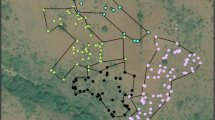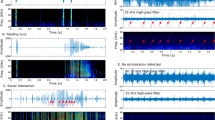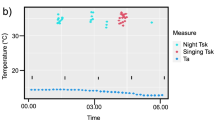Abstract
Many nocturnal katydids (Orthoptera: Tettigoniidae) produce intense calling songs, and some bat species use these songs to detect and locate prey. One Nearctic katydid species, Neoconocephalus ensiger, ceases or pauses singing in response to bat echolocation calls. We tested the hypothesis that song cessation is an effective defence against gleaning bats (i.e., bats that take prey from surfaces). We observed Myotis septentrionalis, a sympatric bat species that uses prey-generated sounds when gleaning, attack and feed on singing N. ensiger in an outdoor flight room. These bats demonstrated a preference for the calling song of N. ensiger over a novel cricket calling song when they were broadcast from a speaker in the flight room. Bats attacked speakers broadcasting N. ensiger calling song as long as the song was continuous and aborted their attack if the sound stopped as they approached, regardless of whether a katydid was present as a physical target on the speaker. Echolocation calls were recorded during attacks and no significant differences were found between continuous and interrupted song approaches for four call parameters, suggesting that M. septentrionalis may not use echolocation to locate silent prey. Therefore, song cessation by katydids in response to ultrasound is an effective defence against gleaning bats.



Similar content being viewed by others
References
Acharya L, McNeil JN (1998) Predation risk and mating behavior: the responses of moths to bat-like ultrasound. Behav Ecol 9:552–558
Anderson ME, Racey PA (1993) Discrimination between fluttering and non-fluttering moths by brown long-eared bats, Plecotus auritus. Anim Behav 46:1151–1155
Anthony ELP, Kunz TH (1977) Feeding strategies of the little brown bat, Myotis lucifugus, in Southern New Hampshire. Ecology 58:775–786
Arlettaz R (1996) Feeding behaviour and foraging strategy of free-living mouse-eared bats, Myotis myotis and Myotis blythii. Anim Behav 51:1–11
Arlettaz R, Jones G, Racey PA (2001) Effect of acoustic clutter on prey detection by bats. Nature 414:742–745
Bailey WJ, Haythornthwaite S (1998) Risks of calling by the field cricket Teleogryllus oceanicus; potential predation by Australian long-eared bats. J Zool, Lond 244:505–513
Barber JR, Razak KA, Fuzessery ZM (2003) Can two streams of auditory information be processed simultaneously? Evidence from the gleaning bat Antrozous pallidus. J Comp Physiol A 189:843–855
Belwood JJ, Morris GK (1987) Bat predation and its influence on calling behavior in Neotropical katydids. Science 238:64–67
Brack V, Whitaker JO (2001) Foods of the northern myotis, Myotis septentrionalis, from Missouri and Indiana, with notes on foraging. Acta Chiropterol 3:203–210
Caceres MC, Barclay RMR (2000) Myotis septentrionalis. Mammalian Species 634:1–4
Caire W, LaVal RK, LaVal ML, Clawson R (1979) Notes on the ecology of Myotis keenii (Chiroptera, Vespertilionidae) in Eastern Missouri. Am Mid Nat 102:404–407
Carter TC, Menzel MA, Owen SF, Edwards JW, Menzel JM, Ford WM (2003) Food habits of seven species of bats in the Allegheny plateau and ridge and valley of West Virginia. Northeast Nat 10:83–88
Conner WE (1999) ‘Un chant d’appel amoureux’: acoustic communication in moths. J Exp Biol 202:1711–1723
Dawkins R, Krebs JR (1979) Arms races between and within species. Proc R Soc Lond B 205:489–511
Endler JA (1991) Interactions between predators and prey. In: Krebs JR, Davies NB (eds) Behavioural ecology: an evolutionary approach. 3rd edn. Blackwell Scientific Publications, Oxford, pp 169–196
Ewing WG, Studier EH, O’Farrell MJ (1970) Autumn fat deposition and gross body composition in three species of Myotis. Comp Biochem Physiol 36:119–129
Faure PA, Barclay RMR (1992) The sensory basis of prey detection by the long-eared bat, Myotis evotis, and the consequences for prey selection. Anim Behav 44:31–39
Faure PA, Barclay RMR (1994) Substrate-gleaning versus aerial-hawking: plasticity in the foraging and echolocation behaviour of the long-eared bat, Myotis evotis. J Comp Physiol A 174:651–660
Faure PA, Hoy RR (2000a) The sounds of silence: cessation of singing and song pausing are ultrasound-induced acoustic startle behaviors in the katydid Neoconocephalus ensiger (Orthoptera; Tettigoniidae). J Comp Physiol A 186:129–142
Faure PA, Hoy RR (2000b) Neuroethology of the katydid T-cell. I. Tuning and responses to pure tones. J Exp Biol 203:3225–3242
Faure PA, Fullard JH, Dawson JW (1993) The gleaning attacks of the Northern long-eared bat, Myotis septentrionalis, are relatively inaudible to moths. J Exp Biol 178:173–189
Fenton MB, Gaudet CL, Leonard ML (1983) Feeding behaviour of the bats Nycteris grandis and Nycteris thebaica (Nycteridae) in captivity. J Zool, Lond 200:347–354
Findley JS (1993) Bats: A Community Perspective. Cambridge University Press, Cambridge
Grant JDA (1991) Prey location by two Australian long-eared bats, Nyctophilus gouldi and N. geoffroyi. Aust J Zool 39:45–56
Greenfield MD, Baker M (2003) Bat avoidance in non-aerial insects: the silence response of signaling males in an acoustic moth. Ethology 109:427–442
Griffith LA, Gates JE (1985) Food habits of cave-dwelling bats in the central Appalachians. J Mammal 66:451–460
Gwynne DT (1977) Mating behavior of Neoconocephalus ensiger (Orthoptera: Tettigoniidae) with notes on the calling song. Can Ent 109:237–242
Hosken DJ, Bailey WJ, O’Shea JE, Roberts JD (1994) Localisation of insect calls by the bat Nyctophilus geoffroyi (Chiroptera: Vespertilionidae): a laboratory study. Aus J Zool 42:177–184
Hoy RR (1992) The evolution of hearing in insects as an adaptation to predation from bats. In: Webster DB, Fay RR, Popper AN (eds) The evolutionary biology of hearing. Springer, New York, pp 115–129
Hoy RR, Robert D (1996) Tympanal hearing in insects. Annu Rev Entomol 41:433–450
Hübner M, Wiegrebe L (2003) The effect of temporal structure on rustling-sound detection in the gleaning bat, Megaderma lyra. J Comp Physiol A 189:337–346
Jones G, Barabas A, Elliott W, Parsons S (2002) Female greater wax moths reduce sexual display behavior in relation to the potential risk of predation by echolocating bats. Behav Ecol 13:375–380
Jones G, Webb PI, Sedgeley JA, O’Donnell CFJ (2003) Mysterious Mystacina: how the New Zealand short-tailed bat (Mystacina tuberculata) locates insect prey. J Exp Biol 206:4209–4216
Kardong KV, Berkhoudt H (1999) Rattlesnake hunting behavior: correlations between plasticity of predatory performance and neuroanatomy. Brain Behav Evol 53:20–28
Kavaliers M, Choleris E (2001) Antipredator responses and defensive behavior: ecological and ethological approaches for the neurosciences. Neurosci Biobehav Rev 25:577–586
Lee Y-F, McCracken GF (2004) Flight activity and food habits of three species of Myotis bats (Chiroptera: Vespertilionidae) in sympatry. Zoological Studies 43:589–597
Libersat F, Hoy RR (1991) Ultrasonic startle behavior in bushcrickets (Orthoptera; Tettigoniidae). J Comp Physiol A 169:507–514
Miller LA, Surlykke A (2001) How some insects detect and avoid being eaten by bats: tactics and countertactics of prey and predator. BioScience 51:570–581
Miller LA, Treat AE (1993) Field recordings of echolocation and social signals from the gleaning bat Myotis septentrionalis. Bioacoustics 5:67–87
Montgomerie R, Weatherhead PJ (1997) How robins find worms. Anim Behav 54:143–151
Neuweiler G (1989) Foraging ecology and audition in echolocating bats. Trends Ecol Evol 4:160–166
Neuweiler G (1990) Auditory adaptations for prey capture in echolocating bats. Physiol Rev 70:615–641
New JG (2002) Multimodal integration in the feeding behaviors of predatory teleost fishes. Brain Behav Evol 59:177–189
Norberg UM, Rayner JMV (1987) Ecological morphology and flight in bats (Mammalia; Chiroptera): wing adaptations, flight performance, foraging strategy and echolocation. Phil Trans R Soc Lond B 316:335–427
Ratcliffe JM, Dawson JW (2003) Behavioural flexibility: the little brown bat, Myotis lucifugus, and the northern long-eared bat, M. septentrionalis, both glean and hawk prey. Anim Behav 66:847–856
Ratcliffe JM, Fullard JH (2005) The adaptive function of tiger moth clicks against echolocating bats: an experimental and synthetic approach. J Exp Biol 208:4689–4698
Ratcliffe JM, Fenton MB, Shettleworth SJ (2006) Behavioral flexibility positively correlated with relative brain volume in predatory bats. Brain Behav Evol 67:165–176
Ryan MJ, Tuttle MD (1987) The role of prey-generated sounds, vision, and echolocation in prey localization by the African bat Cardioderma cor (Megadermatidae). J Comp Physiol A 161:59–66
Sakaluk SK, Belwood JJ (1984) Gecko phonotaxis to cricket calling song—a case of satellite predation. Anim Behav 32:659–662
Sales G, Pye D (1974) Ultrasonic communication by animals. Chapman and Hall, London
Schmidt S (1988) Evidence for a spectral basis of texture perception in bat sonar. Nature 331:617–619
Schmidt S, Hanke S, Pillat J (2000) The role of echolocation in the hunting of terrestrial prey—new evidence for an underestimated strategy in the gleaning bat, Megaderma lyra. J Comp Physiol A 186:975–988
Schulze W, Schul J (2001) Ultrasound avoidance behaviour in the bushcricket Tettigonia viridissima (Orthoptera: Tettigoniidae). J Exp Biol 204:733–740
Schumm A, Krull D, Neuweiler G (1991) Echolocation in the notch-eared bat, Myotis emarginatus. Behav Ecol Sociobiol 28:255–261
Simmons LW (2004) Genotypic variation in calling song and female preferences of the field cricket Teleogryllus oceanicus. Anim Behav 68:313–322
Soutar AR, Fullard JH (2004) Nocturnal anti-predator adaptations in eared and earless Nearctic Lepidoptera. Behav Ecol 15:1016–1022
Spangler HG (1984) Silence as a defense against predatory bats in two species of calling insects. Southwest Nat 29:481–488
Stapells DR, Picton TW, Smith AD (1982) Normal hearing thresholds for clicks. J Acoust Soc Am 72:74–79
Templeton CN, Shriner WM (2004) Multiple selection pressures influence Trinidadian guppy (Poecilia reticulata) antipredator behavior. Behav Ecol 15:673–678
ter Hofstede HM, Fullard JH (2008) The neuroethology of song cessation in response to gleaning bat calls in two species of katydids, Neoconocephalus ensiger and Amblycorypha oblongifolia. J Exp Biol 211:2431–2441
Tuttle MD (1974) Improved trap for bats. J Mammal 55:475–477
Tuttle MD, Ryan MJ, Belwood JJ (1985) Acoustical resource partitioning by two species of Phyllostomid bats (Trachops cirrhosus and Tonatia sylvicola). Anim Behav 33:1369–1371
von der Emde G, Bleckmann H (1998) Finding food: senses involved in foraging for insect larvae in the electric fish Gnathonemus petersii. J Exp Biol 201:969–980
Walker TJ, Moore TE (2007) Singing Insects of North America. http://buzz.ifas.ufl.edu
Waters DA, Jones G (1995) Echolocation call structure and intensity in five species of insectivorous bats. J Exp Biol 198:475–489
Werner TK (1981) Responses of nonflying moths to ultrasound: the threat of gleaning bats. Can J Zool 59:525–529
Whitaker JO (1972) Food habits of bats from Indiana. Can J Zool 50:877–883
Whitaker JO (2004) Prey selection in a temperate zone insectivorous bat community. J Mammal 85:460–469
Wilson DE (1973) Bat faunas: a trophic comparison. Syst Zool 22:14–29
Zuk M, Kolluru GR (1998) Exploitation of sexual signals by predators and parasitoids. Quart Rev Biol 73:415–438
Acknowledgements
We are grateful for the accommodations and facilities provided by the Queen’s University Biological Station during this project and to Frank Phelan for logistical support. Thanks to Reese Arh and Maria Naccarato for field assistance and Peter Wall for the custom MATLAB sound-generating application. The manuscript was improved by comments from Rob Baker, Brock Fenton, Holger Görlitz, Darryl Gwynne, and an anonymous reviewer. Funding was provided by a Natural Sciences and Engineering Research Council of Canada (NSERC) Discovery grant to JHF, an NSERC postgraduate scholarship to HMtH, an NSERC postdoctoral fellowship to JMR, and an NIH grant to Ron Hoy (Cornell University). The protocols used in this study conformed to the guidelines of the Canadian Council on Animal Care and were approved by the animal care committees of the University of Toronto Mississauga and Queen’s University. Legal permission to capture bats was obtained from the Ontario Ministry of Natural Resources (Wildlife Scientific Collector’s Authorisation No. 1031919).
Author information
Authors and Affiliations
Corresponding author
Additional information
Communicated by L. Simmons
Rights and permissions
About this article
Cite this article
ter Hofstede, H.M., Ratcliffe, J.M. & Fullard, J.H. The effectiveness of katydid (Neoconocephalus ensiger) song cessation as antipredator defence against the gleaning bat Myotis septentrionalis . Behav Ecol Sociobiol 63, 217–226 (2008). https://doi.org/10.1007/s00265-008-0652-y
Received:
Revised:
Accepted:
Published:
Issue Date:
DOI: https://doi.org/10.1007/s00265-008-0652-y




